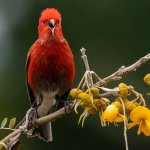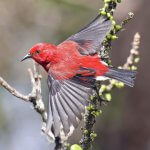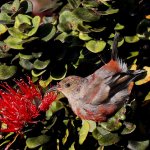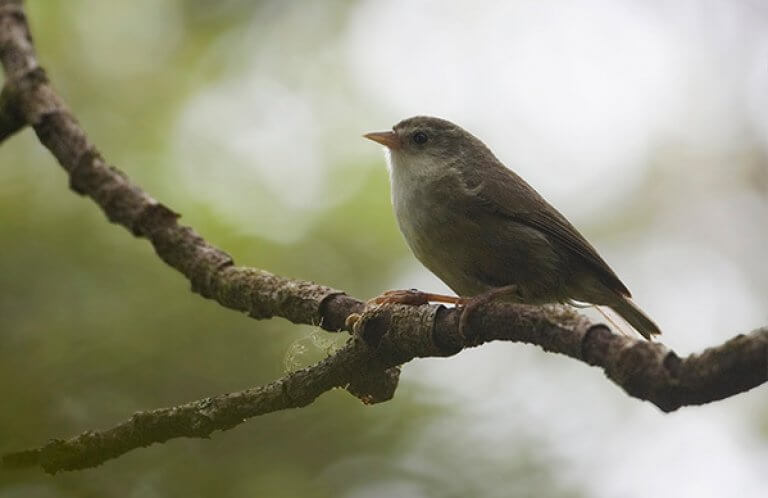About the ‘Apapane
The bright crimson ‘Apapane is part of a group of native Hawaiian birds, reminiscent of – but even more diverse than – the famed Galápagos finches. Known as the Hawaiian honeycreepers, these birds evolved into a varied group of dozens of species that originated from a few wayward ancestors. The ‘Apapane's red feathers give the bird its scientific name of “blood-colored cloak."
There were once more than 50 honeycreeper species found only in the Hawaiian Islands, but today just 17 remain, including the ‘I‘iwi and Kiwikiu, or Maui Parrotbill. The ‘Apapane is the most plentiful.
Putting Up Resistance?
Found nowhere else but their native islands, Hawaiian forest birds are the most imperiled avian group in the U.S. One of the most pressing threats to these birds is introduced avian malaria, to which most of the birds including the Critically Endangered ‘Akikiki and ʻAkekeʻe exhibit little to no immunity. While introduced mosquitoes and the diseases they carry were once limited to lower, coastal elevations by the colder temperatures of higher elevation forests, the warming temperatures caused by climate change have allowed them to expand higher into the islands' mountains — the last strongholds for most of Hawaiʻi's forest birds.
As ABC and partners work to stem disease-carrying mosquito populations, the ‘Apapane provides some hope: Increased detections of this songbird in mid- and low-elevation forests provide a heartening sign that at least this species, along with the Hawai‘i ‘Amakihi, might be developing resistance to mosquito-borne diseases.
Songs and Sounds
Male ‘Apapane are well-known singers, with at least six different calls and ten different song patterns, including a wide variety of squeaks, whistles, rasping notes, clicking sounds, and melodic trills.
Listen here:
Two individuals countersinging:
Breeding and Feeding
Nests Beyond the Fray
‘Apapane nesting coincides with nectar production by their main food tree, the ‘ōhi‘a. Both female and male construct the nest, spending five to eight days tugging pieces out of old nests of other birds and collecting moss, some twigs and leaves, and various fine materials to craft a cup nest. The structure is often placed high on an upward-pointing tree branch, just below the last leaf cluster.
Although many ‘Apapane nests are in ʻōhiʻa trees, this bird also nests in other trees, and sometimes in tree cavities, tree ferns, and even lava tubes. When a pair nests in an ʻōhiʻa tree, it is usually one that is not blooming; this is likely to reduce the chance of conflict with ‘Apapane and other honeycreeper species such as Ākohekohe feeding at flowers nearby.
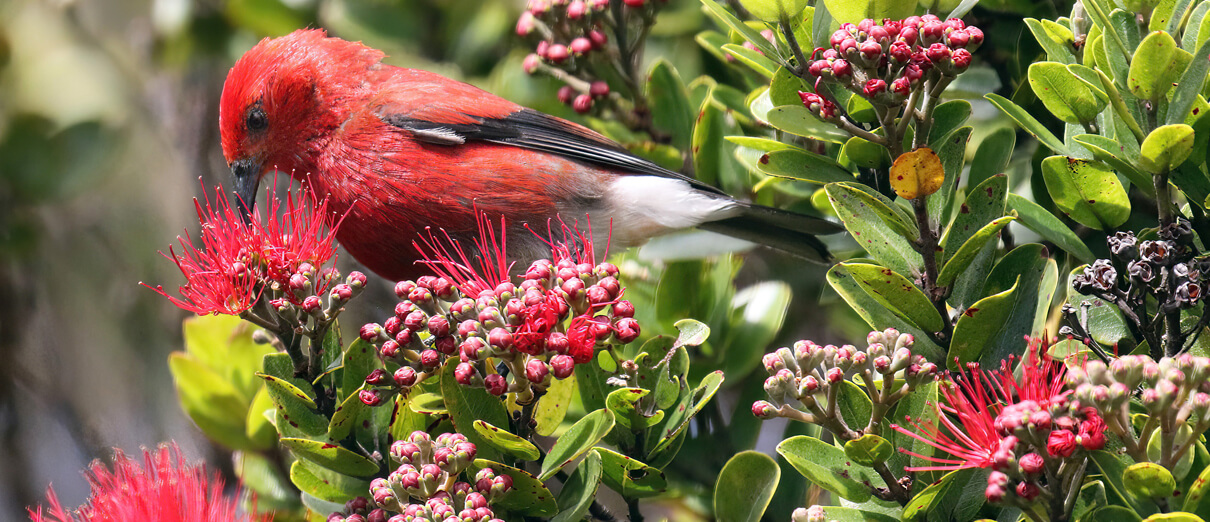
After nest-building is done, the female usually lays three whitish, tan- to dark brown-splotched eggs, which she alone incubates for almost two weeks. At times, the female leaves the nest and is fed by the male, after she lands nearby and lowers her wings, shaking them like a begging nestling. Chicks hatch bare, with just a smattering of down on their heads, backs, and wings. Both parents feed their nestlings caterpillars and other protein-rich foods. After a bit more than two weeks, the young fledge, but they shadow at least one parent for up to several months before truly striking out on their own.
Sweet Wanderings
‘Apapane have brush-tipped tongues adapted for sipping nectar, and this bird relies heavily on the nectar of ‘ōhi‘a flowers. In turn, the bird is an important pollinator of this tree. ʻApapane wander widely on and even between their home islands, following the blooming of trees. Although the species primarily feeds on nectar, it also consumes a variety of insects.
Region and Range

ʻApapane occur on Hawaiʻi Island, Maui, Lānaʻi, Molokaʻi, Oʻahu, and Kauaʻi. More than 80 percent of the population occurs on Hawai‘i Island, where the birds live in higher-elevation ʻōhiʻa forests, especially in Hawaiʻi Volcanoes National Park. There are also sizeable populations on both Maui and Kauaʻi. O‘ahu shelters some healthy populations, but this bird is rare on Molokaʻi and Lānaʻi.
Conservation
Safe – For Now
Although the ‘Apapane is not endangered, it is vulnerable to the same challenges threatening other Hawaiian birds, including habitat loss, introduced plants and animals, and climate change. This species has one of the highest rates of avian malaria due to its seasonal migrations to lower-elevation forests, with an approximately 60-percent mortality from the mosquito-borne disease. Rapid ‘Ōhi‘a Death, a fungal disease which kills this native tree so vital to many native honeycreepers, is another particular threat.

Help support ABC's conservation mission!
ABC is dedicated to the survival of the remaining Hawaiian honeycreepers and the islands' other endemic birds. As part of the Birds, Not Mosquitoes initiative, ABC works with partners on a large-scale effort aimed at curbing the islands' non-native mosquito populations. To do this, the partners propose by deploying a naturally occurring bacteria as “birth control” to reduce mosquito numbers in high-altitude forest bird habitat across the islands.
In June 2023, U.S. Secretary of the Interior Deb Haaland announced the commitment of nearly $16 million in federal funding to restore populations of dwindling endemic Hawaiian songbirds, under the Hawaiian Forest Bird Conservation Keystone Initiative. Among the actions to be funded: expanded captive care programs for the most at-risk species; work to control and eradicate invasive mosquitoes that spread avian malaria; and translocation of bird populations to higher elevations, beyond the reach of mosquitoes. Another goal is engagement in these efforts with Native Hawaiian cultural practitioners and experts.
In 2022, ABC and partners on Kauaʻi fought to reduce the impact of free-roaming cats on that island, supporting the introduction and passage of legislation prohibiting cat abandonment and feeding on county properties. ABC also helped defeat state legislation that would have resulted in more cats on the landscape.
Get Involved
Policies enacted by the U.S. Congress and federal agencies have a huge impact on Hawai'i's birds. You can help shape these rules for the better by telling lawmakers to prioritize birds, bird habitat, and bird-friendly measures. To get started, visit ABC's Action Center.
Our Hawaiian partners frequently need help with habitat restoration and other projects benefiting birds. If you live in or will be visiting Hawai'i and would like to volunteer, check the following Facebook accounts for opportunities: Kaua'i Forest Bird Recovery Project, Maui Forest Bird Recovery Project, and Mauna Kea Forest Restoration Project.
American Bird Conservancy and local partners are restoring forests, protecting critical habitat, and much more to save native Hawaiian birds. This is a monumental undertaking, requiring the support of many, and you can help by making a gift today.






































